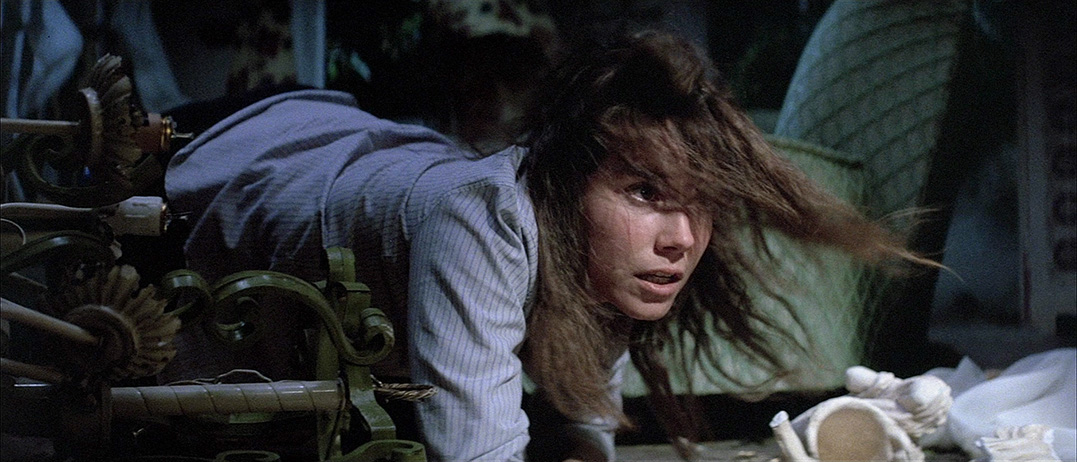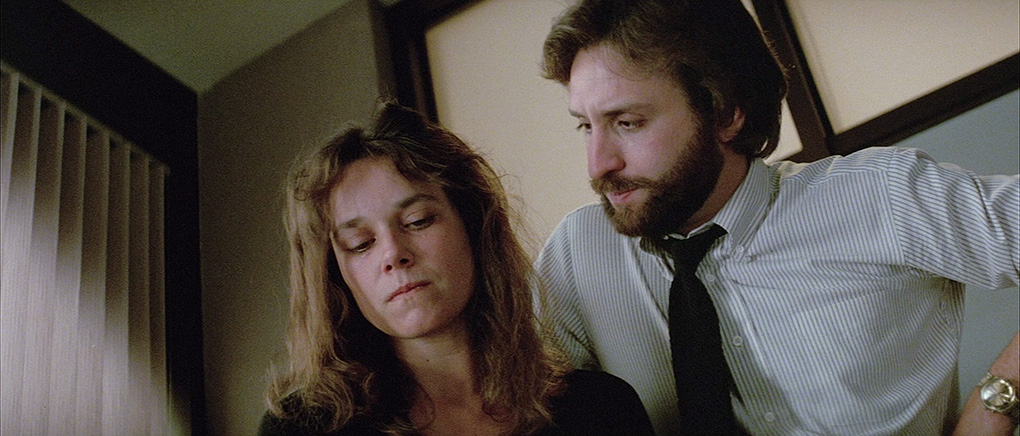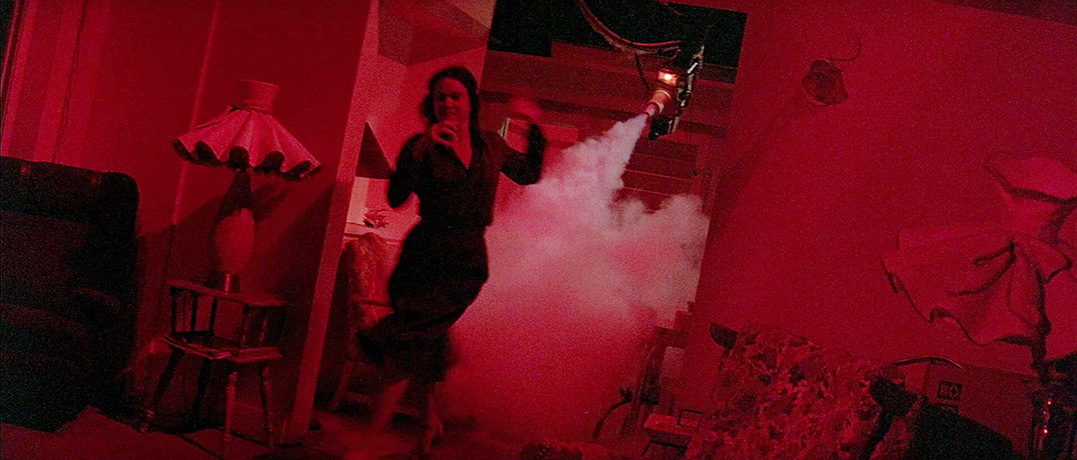|
Sidney J. Furie's 1982 The Entity is, amongst other things, an intriguing barometer of a surprisingly common critical double-standard. A horror film with strong subtextual overtones, it is centred around a woman who is being violently abused and raped by a powerful and malicious poltergeist. Inevitably and understandably, most of those who are heavily critical of the film have attacked it for this element, chastising it for being exploitative and for attempting to craft an entertainment on the back of the appalling suffering that such abuse causes. And to a degree at least, they're absolutely right. But many of those very same dissenters appear to have no issue with the often graphic violence inflicted on all manner of individuals in countless other genre works. Death, dismemberment and suffering are fine, but rape is bad. Well here’s the thing, they're actually all bad, and they're all equally bad.
The whole debate around the exploitative nature of entertainment cinema has raged for years and will no doubt continue to do so long after I've met a suitably grisly end. In generic terms, horror is always going to be at the epicentre of this discussion, as by its very nature the horror genre exploits both its subject matter and our own deeply rooted fears. That, as they say, is the nature of the beast. If you are dealing in horror then you are also dealing in exploitation, and if you are a horror fan you can either be aware of this or choose to ignore it, but either way you are going to get your intellect wet. Within this debate, the issue of personal politics inevitably causes sub-divisions and demarcation lines. Rape is a particularly emotive subject that filmmakers and audiences have become increasingly sensitive to in recent years. Thus, the casual comic references in Blazing Saddles ("You said 'rape' twice" – "I like rape") nowadays sit awkwardly amidst the still-smart digs at liberal race guilt, while Clint Eastwood's shut-her-up assault on the mouthy saloon girl in the otherwise stylish High Plains Drifter uncomfortably reflects an attitude to the crime that seems painfully archaic today.

As with any other form of human suffering, rape is inevitably going to be part of film drama, but the smart consensus is that if it has to be shown, then it should not be portrayed as a positive experience for the victim or a remotely titillating one for the audience. The notoriously complicit rape scene in Sam Peckinpah's Straw Dogs continues to be a huge problem even for fans of the film (myself included), and The Entity director Sidney J. Furie lacks the near-indestructible sheen that is afforded to cinema's more celebrated auteurs. There is, as yet, no snob value in championing post-Ipcress File Furie.
In recent years, the debate has intermittently resurfaced through films like The Accused, The War Zone and, of course, Gasper Noé's Irréversible, whose harrowing ten-minute rape scene is almost impossible to watch. As it should be. What links all three of these films is that their depiction of rape is singularly focused on the suffering that this very male form of assault causes its victim. That The Entity also takes this stance should theoretically also qualify it as victim-centred, but there's one prejudicial problem – this is not a social drama but a horror movie, and if all horror movies are exploitation by default then it’s safe to assume that this film must treat rape in an exploitative way. QED.
Except it's not quite that simple, for while the prime purpose of any fear-driven horror tale is to scare its audience – and the assaults here can certainly be viewed as a tool insensitively employed to that end – the strongly subtextual nature of the genre allows for a very different reading, and one that directly challenges this viewpoint. The central character of Carla Moran is a single mother who suddenly and repeatedly suffers sexual assault at the hands of a malevolent spirit. Even her closest friend has trouble believing her and recommends she visit University psychiatrist Phil Sneiderman, who is convinced that the problem is all in Carla's mind. As the attacks continue and their violence increases, Sneiderman remains convinced that the resulting wounds are all self-inflicted, prompting Carla to engage the help of parapsychologist Dr. Elizabeth Cooly and her team, who ultimately propose a way to isolate and perhaps destroy the Entity in question.

As a straight-up horror story, this is largely familiar woman-as-terrorised-victim stuff, but placed in a social context this is also film about spousal/boyfriend abuse and the effect that it has on the victim and those closest to her. Initially, Carla's claims that she has been raped are not believed and her horrific bruises passed off as the result of self-harm. Within the context of the supernatural story presented here, this is somewhat inevitable, but it should also prove chillingly familiar to anyone who is close to someone who has suffered physical or sexual abuse from their partner and not been taken seriously by others because, "Oh come on, he wouldn't do something like that!" In this respect, the film's masterstroke is is to make whatever it is that attacks Carla invisible and strip it of identity or back-story detail, preventing any audience identification with the rapist and making the effect of the assaults on the victim the only focus of these scenes. That they are uncomfortable at best and often downright disturbing seems only right, and that we should dread the onset of another attack – whose arrival is signified by tilted camera angles and a crashing score that accentuates both their violence and the sexual nature of the assault – prompts questions that go beyond film and into the real world about just what it means to be a prisoner of violence within your own home and family. This is especially evident the first time an assault is witnessed by others, whom logic dictates should be Carla's own children – the younger two are traumatised by what they see while teenage son Billy instinctively attempts to fight off the attacker and suffers a broken wrist for his troubles.
Expectations are sometimes surprisingly undercut, with well-meaning psychiatrist Phil Sneiderman offering both hope and the possibility of a stable romantic future for Carla, yet his refusal to accept a paranormal explanation and his stubborn dedication to the theories of his profession ultimately sabotage his knight-in-shining-armour potential and cast him as a betrayer, a man who clings to cold logic when what Carla needs most is sympathy and faith. It's a similar story with money-minded boyfriend Jerry, who when confronted head-on with the truth elects to deny what he has seen and run away. Carla is left unable to seek help from the men in her life, none of whom appears to be up to the job, and it is left to her to lead the fight back, an act of self-empowerment that gives her moral strength but could ultimately result in her physical destruction.

That we buy into every aspect of this gradual transformation from terrified victim to determined survivor is down primarily to lead actor Barbara Hershey, who delivers an astonishingly brave and self-confident performance in a role that few would have taken without requiring some serious changes to the script, with one full body nude scene (admittedly, there is prosthetic make-up involved here) presenting the actress in an almost uncomfortably frank state of vulnerability. It is Hershey's total immersion in the role that engages us so much with her plight, makes the suffering and fear real, and her determination to fight back against her aggressor so credible. Performances elsewhere are solid enough, but Ron Silver's sometimes infuriating self-assurance as Sneiderman is urgently naturalistic and never comes across as script-fed. His unwavering conviction that Carla's wounds are self-inflicted in some ways recalls the stubbornly intransigent doctors in The Exorcist – in the real wortld he and they would make complete sense, but in the framework of the movie we absolutely know they are wrong and want them, above all else, to realise that.
But social subtext aside, this is still on the surface a horror movie and on this score The Entity tends to shine. Screenwriter Frank De Felitta and director Sidney J. Furie waste little time on build-up, providing instead a rough sketch of the central character (strong-willed and independently minded single mother with three kids from two different fathers, financially strapped but studying to improve her social situation), then hitting us and her with the first attack just seven minutes into the film. The tension kicks in from this point and infests Carla's house and pretty much every scene set in it, quickly building an atmosphere of constant unease and intermittent dread that sometimes explodes into some very well calculated jump-scares. The dialogue wobbles a little in the early stages, but in moments of conflict and crisis it really sparks, with a pivotal exchange between Carla and Sneiderman that results in her rejecting his help providing a showcase for the considerable talents of both actors.

It is following this that the film moves into more familiar territory, with the introduction of the (female captained) parapsychology team and its equipment recalling both Robert Wise's 1963 The Haunting and John Hough's 1973 The Legend of Hell House. There are also strong similarities to Tobe Hooper's Poltergeist, which was released almost simultaneously in UK cinemas and easily eclipsed The Entity in press attention and box-office returns. For my money, however, Poltergeist was always the lesser work, having executive producer Steven Spielberg's sticky fingerprints all over it and a fondness for shouting where The Entity talks in hushed tones. This is most effectively demonstrated by the same narrative point in both films, when the initially sceptical parapsychologists are persuaded to take on the case – in Poltergeist, this involved an almost comically over-the-top special effect involving a room full of whirling objects, whereas in The Entity it is achieved with something as simple as a trembling mirror. Where The Entity falls into a similar trap is in its climactic scene, an attempt to end the film on a big bang that suffers from an invasion of action movie scale and logic – having made a point of demonstrating the deadly effects of liquid helium, the film then has its characters dodge and outrun it and even get hit by it without ever suffering its harmful effects.
But on the whole, The Entity delivers and does so big time. What lifts it above so many of its sub-generic ilk (Poltergeist included) is that it tells an engrossing story and – kind of important for a horror movie – is genuinely scary. That it trips up a bit on the final leg does it no serious harm, though how you'll react to the final 'based on fact' coda will depend on your views on the existence or otherwise of supernatural forces. As a confirmed unbeliever, I have to admit that in the real world I’d probably be siding with Phil Sneiderman, and it's a testament to this well-executed horror story that, for just a couple of hours, I'd buy into the ghost story and openly tell Sneiderman to his face that he's a fool.
It’s been 12 years since the film was released on UK DVD by 20th Century Fox, and though the anamorphic transfer was a solid enough job for its time and format, the 1080p one on this new Eureka Blu-ray wipes the floor with in in every respect. All the detail softness on the DVD has been brought into crisp focus here, and the variable black levels have been stabilised and remain rock solid throughout. The colour is well defined without over-saturation, and the image integrity and shadow detail remain impressive even when the light levels drop, important given how many scenes take place at night. The only casualty of this definition increase is that the optical effects are more transparent here and the quality drop on matte shots more clearly visible. A few minor dust spoots and small hairs remain, but otherwise the image is clean. The framing is the original 2.35:1.

The DTS-HD Master Audio 5.1 surround track also improves on the Dolby 4.1 track of the DVD (and no, that isn't a numerical typo), having better dialogue clarity and adding more punch to Charles Bernstein’s pounding score. The surrounds are subtly employed, but really come to life in a couple of key sequences, notable one involving sparking electrical discharge.
Optional English subtitles for the deaf and hearing impaired are also available.
One aspect of the disc that I do feel the need to give a thumbs-down to is the image used for menu screen, as while I have no doubt at all that it's a reproduction of a piece of the film’s original promotional artwork, its image of a naked woman in what looks like the throes of ecstasy being hit by supernatural lightning bolts does tend to piss on the arguments I've made above in the film’s favour by sexualising the act of paranormal rape. Half of that image – with a painted-out nipple, of course – has also been used for the disc cover art.
Two specific things I was looking forward to when I first heard the news that The Entity was getting a Blu-ray release from Eureka, at least when compared the previous DVD, were the inevitable bump in the picture and sound quality (see above), and an expansion of the special features beyond the paltry trailer included with the original. Disappointingly, that's also the only extra we get here, the exact same Trailer (1:22), which is in only marginally better shape than the visually soft and sonically fluffy one included on the DVD.
A hugely contentious premise is handled with more thought and sensitivity than you might expect, resulting in a film that is tense and involving but also registers as an allegorical tale of domestic abuse and its impact on the victim and those closest to her. Barbara Hershey’s performance is the star attraction, but director Furie keeps the horror on the right side of cheap exploitation and delivers a still-strong genre piece whose frequently threatened remake has thankfully yet to appear. Recommended for the film and the fine Blu-ray transfer, but the lack of any new special features is disappointing.
The main review has been updated from our earlier coverage of the 2005 20th Century Fox DVD release.
|